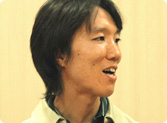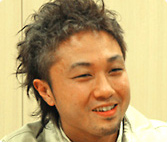4. Fun to Watch as Well as Play
A lot of people have already found Wii Sports to be extremely approachable and fun in a really easy-to-comprehend, intuitive way. But on the other hand, it seems that the more experienced gamers are, the more concerned they are that they will quickly tire of the game. This seems to be due to a vague association between games which are easy to grasp and games that lack depth, and therefore soon become boring. But once you actually play this game, it becomes clear that this couldn't be further from the truth. I'd like therefore to ask the individual directors about the depth the games in Wii Sports have. Let's begin with Tennis.

Ok. As someone who has always developed "traditional" games, I knew that Tennis would have to contain those deeper elements that would appeal to gamers. The first such idea I had was that the ball's movements could be altered by the way the player swings the controller, be that a slice, a topspin shot, or whatever.
That still surprises me. I'm still not completely sure how the movement of the ball can vary so much, just through a swing of the Wii Remote.
To put it simply, it's because we put a lot of thought into it! (laughs)
Are there any other elements in the game that add to its depth?
The fundamental factor giving the game depth comes from the fact that there is such a huge level of variation in the controls. So much in fact, that you could probably say it's impossible to hit the same shot twice. As the data picked up by the Wii concerning how you moved your wrist and the angle you turned the controller is all analogue, if you hit the ball 100 times, that action is going to be reflected on the screen in 100 different ways. What I'm saying is that every time you play, the conditions will be slightly different. The player can enjoy trying out different strokes to see what happens, constantly learning in a sensory way. I think it will take a long time for the player to get the hang of all of the movements, and the process of feeling oneself improve at the game is really enjoyable for the player. Another, more "game-like" element is the fact that we have made around 60 computer-controlled characters for the players to take on. As some of those characters are formidable opponents, it is enjoyable to work on acquiring the skills you'll need to beat them. In addition, there is a "Skill Level" in the game which gives the player an easy-to-understand numerical indication of how they are progressing, which they can check at any time. By watching this "Skill Level" increase, you can feel yourself developing as a player, which is fun. There is also a recent feature we added called the "Rocket Serve". If you time your swing of the remote just right and hit the ball when it is at its highest point, you will hit a really fast serve.

The addition of this single feature really changes the feel of a match.
That's right. It really adds to the excitement for both the server and the player receiving the serve!
Yamashita-san, can you tell us about the depth that Baseball has?
Well, baseball is very much a mind-game, isn't it? Since you play alongside your opponent, and pitch or hit the ball while talking to each other, there are elements in the game that go beyond hand-eye co-ordination.
So for instance, you could make your opponent think you're going to pitch a fastball, but then actually throw a forkball.7 7A forkball is a type of pitch, favoured by a number of famous Japanese pitchers, where the ball is held between the first two fingers, causing it to drop suddenly as it nears the batter.
Right. The game has that kind of fun factor which develops off-screen. That kind of fun was also in Baseball back in the NES days. During our internal testing, you could overhear voices that you wouldn't normally hear during testing. Even if they were quite far away, you could tell right away: "Ah, they're playing baseball!"
And how about Boxing?
At first glance, you may think Boxing is simply a game where you have to land punches on your opponent, but the important thing is defence, or dodging. This is something I always tell people when they first give Boxing a go: you can dodge punches really well by just leaning your body to the sides in the normal fighting posture.
Not by moving your hands?
That's right. I actually always tell players to move their bodies instead of moving their hands. In fact, the very act of moving your body causes the controller to move, so it only feels like you're holding your hands still. But when giving advice to beginners, I find they can learn to avoid punches better if you tell them to dodge using their body rather than their hands. It's a lot of fun as you sway your body and the Mii on the screen dodges in the same way. So in terms of the best strategy for the game, rather than just blindly throwing punches, it is more effective to first dodge your opponent's punches before getting a punch in on the counter-attack.
I remember something funny from when I was doing the Wii Preview. Before the visitors arrived, I gave a simple demonstration of the game to all of the girls working in the Nintendo booth, and told them "it's good to throw a punch just after you dodge." They seemed to really enjoy it, and throughout the show they kept playing against the visitors. They got really good at counter-attacking, and I got a bit flustered and had to ask them to go easy on the visitors! (laughs)
Once you've grasped the skills such as how best to time your punches depending on the distance between you and your opponent, the game suddenly becomes a whole lot more enjoyable. Needless to say, as you progress further in the game, the Mii opponents you face become tougher. The sense that it's easy at the beginning, but gets gradually more challenging is something you can always expect from Nintendo games. I mean that's classic Nintendo! (laughs)

At the same time, it has all that adrenaline-pumping excitement of a sports tournament, which is also typical of Nintendo.
Right. For the really good players, there is that aspect to the game of "come and have a go if you think you're tough enough!"
Now, Shimamura-san. Tell us about Golf.
Ok. What I really want to tell game fans about are the golf courses in the game. Veteran gamers are probably familiar with the very first Golf game for the NES.
I know it! I worked as the programmer on that game! (laughs)
That's right! (laughs) We've actually taken nine of the best holes from the original 18 on NES Golf for Wii Sports Golf, and brought them back to life in 3D. So people now in their 30s, some of whom may not have played video games for years, will be able to enjoy taking a trip down memory lane when they see what those old-school courses look like in 3D. This overlaps with what Ota-san said about what makes Tennis fun, but to ensure that even the slightest wobble in the swing, as well as its speed, will be reflected in the shot, we have done a lot of fine-tuning. This means that there really are a lot of elements to master.
I see. So tell us about Bowling.
Of course in Bowling, like the other games, the player enjoys analogue-style responsiveness, but I think the easiest way to get you to grasp the depth of this game is by telling you one single fact: in all of the endless testing which Nintendo has done on this game, no one has ever achieved a perfect score!
Really? Is that right?
If you get used to the game, it is not that difficult to get a few strikes in a row. In fact, when you're on good form, it's fun to see how many strikes you can get. Even if someone has never touched the game before, they will be able to knock down a fair number of pins. After all, we did choose to add bowling because it's a sport that everyone can enjoy. But if you are trying to get a perfect score, it's actually extremely difficult.
So no one has done it yet?
Well, at the very least, not to my knowledge.
This is true of all the games on Wii Sports but, in contrast to regular games, it is difficult to do exactly the same thing twice. If you get three strikes in a row, you might think: "Today's my day! I can get a perfect score!" You might think that, but when you come to bowl the next frame, even though the ball is spinning just as you want it to, it may suddenly go straight and you end up with a split. You're left really puzzled: "I wonder why I can't bowl it the same way..."
But if you do bowl it in exactly the same way, the ball will roll the same way.
There aren't any arbitrary random factors, are there?
None at all.
That would be a topic worth exploring further sometime. Something else I enjoyed about Bowling was that you use the button to let go of the ball, and if you are a bit late releasing it, the ball will bounce. You put a lot of thought into things like that, didn't you?
Yes, there are a lot of features packed in there. For instance, in bowling games up to now you could probably only bowl the ball in front of you. But in Wii Sports Bowling, if you bowl the ball behind you, it will roll in that direction. Also, if you really want to, you can even throw it into the neighbouring lanes!
What? You can throw it into the neighbouring lanes?
You can. In previous bowling games, you had to select the position to stand in, the direction and the power in order to bowl. I don't think that kind of system would have enabled you to do something like that, but Wii Sports Bowling allows the player to do all those things they might want to try.
I didn't know that! (laughs)
This is something that is true for all five of the games on Wii Sports, but there are three types of training games on Bowling. Well, they are really just practice modes, but you can get really into the training and the hours just disappear.
Since there is a score in these training games, they can suck you in just as much as the rest of the game.
That's right. Without realising it, you can keep on playing them again and again. A full training game might last three to five minutes, but you might feel you've messed up and keep restarting it after ten seconds or so. When you add up all those short times, before you know it you've played for half an hour or an hour.
Among the Nintendo staff, the competition for who could get the highest score on Target Practice Mode was pretty fierce! There were people who were playing Target Practice Mode whenever they could find free time.
There were lots of conversations with people asking: "What was your score?", or people sneaking a look at other people's scores and being surprised. There was an enjoyment that was a bit reminiscent of the NES days.
The fact that people were talking about scores in itself felt like something that hadn't happened in a long time. Perhaps in games today, scores have lost their value as a topic of conversation.
Yes, you may be right.
Alright, at this point I have a video I would like to show to you all. The video is of a development tool for use with Wii, or should I say it is middleware created by an overseas software company that works with Nintendo. I thought it would be a good idea to show it to all of you since you developed Wii Sports by bringing together a variety of prototype software. So I've decided to work it into this interview. Let's take a look.
To put it simply, with this tool, programming games that use the Wii Remote becomes very easy. Takeda-san is here to explain a bit more about this. Takeda-san, I know you're very busy so thank you very much for joining us.
It's my pleasure. As you saw from the video, this is one of the development tools for Wii. Nintendo puts the same amount of effort and commitment into the creating tools like this as we do into the development of our software. I'm going to explain a little of the background to this. When we released the Nintendo 64 hardware, it was a truly dramatic change as games went from two to three-dimensional. Looking back at the development at that time, including outside software developers, there was a huge divide between those that could quickly adapt to this change, and those that took more time. This resulted in severe delays in the release of software. This time, with the new challenges Wii presents to programmers, there was a fear that there would again be a divide between those who could successfully adapt to the new system and its implementation method, and those who could not. At Nintendo, we have people like Ota-san who have done a great deal of fundamental research on the new hardware, so we don't have anything to worry about, but of course there are places where there aren't people like him. For that reason, as a way of providing a new development environment, we decided we should be able to furnish developers with useful tools like this one. After all, it would be a real waste if people stumbled right at the start of the development process, and all these ideas they went to the trouble of coming up with never came to fruition. Also, another reason was that we want games to include a lot of ideas which don't come just from programmers, who have scientific backgrounds, but also from those game developers with non-scientific backgrounds. Up to now, those non-scientific people have had to go to the programmers and ask them to implement their ideas. If they were able to use this tool to put together simple test software by themselves, based on ideas they came up with, this would lead to a lot of their ideas being used in finished products. So we thought that if we can provide a tool like this, it will become possible for functioning games to be put together even by those who aren't able to write programs. Since we have proposed a completely new input method, we felt we also had to provide new development technology. At Nintendo, a lot of staff can program so ideas begin to take shape quickly, but we realised that in the future we wanted to share these ideas with developers outside the company to aid the development of new products.

As someone who doesn't know how to program, being allowed to try out my own experiments with a tool like this is really great. I think there are a surprisingly large number of people out there who are wondering: "I wonder if this kind of game would work?" In fact, there are a lot of people putting games they have made themselves up on the web. If people like that were able to easily put together new types of games that use the Wii Remote, the number of people making games would increase. That's something I'm really excited about.
Being a programmer myself, I can appreciate how when Ota-san and I started making games, it was possible to release much simpler products than you are today. Because we have witnessed all the stages of development of games from their simple beginnings, we have been able to keep up with the complex technology we have today. But because of that complexity, the gap between people able to get into games programming and those who can't has suddenly become an extremely wide one. At a time like this, putting out this kind of tool will inspire the development of all sorts of unpredictable software.
With this kind of tool, you can find out really quickly whether an idea actually works with the resources you have. If you spend a long time trying out something and find out that it doesn't work in the end, that's not an efficient use of time. If these trials are time-consuming, this means higher labour costs, so for this reason it becomes vital to have a suitable environment for development. To put it simply, it is necessary to have tools that link ideas to the final product. The video we just saw was one example of that. We want to share these kind of tools widely among Wii software developers.
With a tool like this it is certainly going to become possible to try out lots of ideas. As Wii Sports is a game born out of the selection of ideas from various experiments, I can appreciate the true value of this. Even if it is necessary to polish it up to get it ready for release, that simple feeling at the start that an idea works well is very important. If this development tool had been available from the start, it is quite likely that there would be even more games included on Wii Sports.
Which will end up making the producers' lives more difficult…
(laughter)
Thank you very much, Takeda-san.
You're very welcome.
To finish up the interview, let's have a closing remark from each of the individuals who made the games on Wii Sports. We'll start with you, Ota-san.
Wii Sports in its finished form is a game that both game fans and the people around them will find equally enjoyable. It's very accessible, but at the same time it has all the elements which will allow the player to get really absorbed in the game. To give an example of a slightly unusual way to enjoy Tennis, you can play doubles, controlling all four of the players yourself! There are so many ways to play, I just want everyone to have a go!
What I feel certain of after watching a lot of people test this game is that with the five sports, tennis, golf, baseball, bowling and boxing all packaged together, there is something for players of all ages. I want the whole family to play Wii Sports together.
Putting it very simply, I want everyone to use Wii Sports to become more active and work up a sweat. I want to see players punching the air!

Absolutely! Wii Sports is a game that will have players jumping around and punching the air in triumph, isn't it?
Yes, you see everyone doing it!
They give each other high fives too! (laughs)
They do! (laughs) Finally, Eguchi-san.
Looking at games in the past, there are very few examples of games that have the capacity of being able to draw people around into playing them, or which the people watching enjoy just as much as the player. I feel really happy to have been a part of this and what I want most is for a lot of people to experience the game. Wii Sports is also cheap! It's a real bargain!8 (laughs) 8This applies only in Japan. In Europe, North America and Australia, Wii Sports will be included with the Wii console.

Yes, I think it's a real bargain. In fact, Nintendo's intention behind making it that cheap was to give the message: "If you buy a Wii and don't play Wii Sports, you will be missing out!"
I think we have come up with a product about which we can say that with pride! I strongly urge everyone to just give it a go!
It's been a long time since I have seen a game where so many of the people watching were waiting their turn, with that look on their face saying "let me try it out!" In the past, video games really had that factor, but I feel a deep concern that this has gradually weakened over the years. With Wii Sports, what I am most pleased about is that it really has that "let me try!" factor in abundance. Then, five seconds after they start playing, you can see that the new player has already got the hang of it. That's what's great about Wii Sports.
You can guarantee that anyone playing the game will be wearing a huge smile. There aren't many games you can say that about.
Personally speaking, I just want as many people as possible to give it a try. Thank you very much for your time today, gentlemen.
